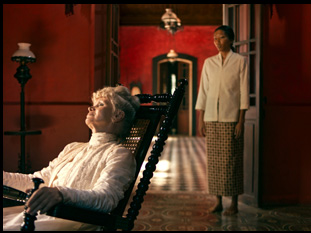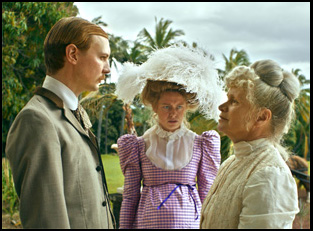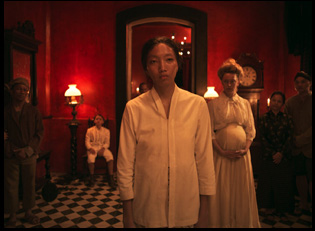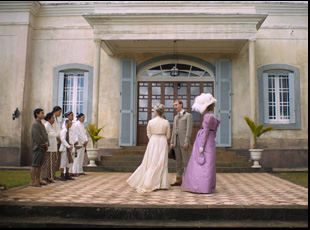It wasn’t as much of a stretch as one might think for Ena Sendijarevic to follow-up her ultramodern coming-of-age drama “Take Me Somewhere Nice,” in which followed a young woman from the Netherlands to Bosnia to engage with the father she’s never met, to make “Sweet Dreams,” set in a Dutch colony in Indonesia at the turn of the 20th century where the sudden absence of a patriarch also leads to chaos. When Sendijarevic separated herself before from a typically solemn genre of coming home tales with brutalist imagery to suggest its central character was the force to be reckoned with, along with her predilection for neon attire, rather than timidly approaching a reckoning, the writer/director has a similar attitude towards taking on a period piece, realizing that when history itself is a construction, it can be a delight to pick it apart.
While taking its title from the sugar plantation that provided for Jan (Hans Dagelet) and his wife Agathe (Renée Soutendijk) for decades, “Sweet Dreams” gets at the bitterness that’s always been at the roots of the cane fields where the indigenous population has been subjugated into servitude. It could be said to a far lesser degree that Agathe has been suffering just as long when it isn’t only those working in the fields that Jan has taken advantage of, but needs to look no further than Karel (Rio Kai Den Haas), the illegitimate son running around the house that he had with their maid Siti (Hayati Azis) to know the extent of his tyranny. Upon Jan’s untimely death, it appears she could take control of the house, though legally she has competition from both the eight-year-old Karel and her own adult son Cornelis (Florian Myjer), who is called back to the plantation with his very pregnant wife Josefien (Lisa Zweerman), to help sort out the will. The fact that she overlooks Siti as a potential threat to the throne is indicative of the other less visible oppression going on in the colony where women refrain from asserting themselves, yet Sendijarevic finds most of the men to be feckless, leaving a void of leadership where true madness can set in.
The filmmaker isn’t afraid of being bold, seeing the setting as a fine place for a dark satire where all the baubles of aristocracy can’t hide the mud it’s been built atop of and fashioning a visual delight that’s subject might be hard to stomach otherwise and it speaks volumes that “Sweet Dreams” has been selected by the Netherlands to represent the country at the Oscars when speaking such an unsavory part of its past. Recently as the film has been making its way around the festival circuit, first making waves at Locarno and Toronto before screening stateside at Chicago, the director spoke about what led her to make “Sweet Dreams,” bringing out sensations that film would seem to be incapable to conveying, and finding the film’s deliciously piquant tone through its music before filming.
How did this initially come about?
After making “Take Me Somewhere Nice,” which I shot in Bosnia, my country of birth, I felt the desire to do something in the Netherlands and I wanted to look at the relation between Western Europe with the rest of the planet and this drew me to the topic of colonialism. Dutch colonial history is something that I didn’t know as much about as I wanted to and I wanted to learn more about it, so that was the starting point.

It’s true that it really started with Agathe, and with an image of a very lush jungle where you would see a Western European woman there being completely out of place, sweating in a white Victorian dress. This was Agathe for me and I first started to write about this woman and as I was writing about how she would be sitting in her mansion, being completely isolated and not being able to have a certain kind of position of power through the legislation in that time, all the other characters were, one by one, born into the story. Her husband and then Siri, the maid, and then Siti’s child and the ensemble of characters grew until they were six.
When you mention the sweat, it’s something you can really feel, just as you express smell in such a tactile way and it’s not a sense you can generally transmit in a film. Was that tricky to achieve?
Yes, I really wanted to film the film to be an experience, not just the story that you look at, but really something [that would be] a feverish dream/nightmare that you would be drowning in, and things like smell I often described in the screenplay. It’s interesting to me how when you write things in a screenplay, even if you cannot see them, which is normally what you shouldn’t do, somehow it does translate, so the sweat was a very important element. You would feel the heat and that would allow you to dive into this insanity that the characters are inhabiting as well.

There will always be a core to the things I’m drawn to, so I wasn’t afraid to drift away too much from my style, but for this film, we were definitely looking for its own visual language. With this screenplay, I really started with just a blank page to really look at what kind of visual influences could we use and what was very important, for example, were these naive primitivist paintings from around 1900. There was this French painter Henri Rousseau, who would paint these very tropical landscapes, even if he never left France, and he would paint them in this very colorful, almost childlike way. There would be a certain exoticizing viewpoint, which made it a bit edgy, so you also feel like, “Okay, is this what I’m looking at? How should I interpret it?” And I thought that would be a certain layer to the film that will make it more interesting, so we used him as an influence a lot, especially when it comes to all the colors, not only the flowers in the nature that we were shooting, but also in the house and all the walls. That was very important to create this very stylized universe of its own, [which] is what’s the same as “Take Me Somewhere Nice,” even if I use very different ingredients in that film. Some ingredients are similar – certain lens choices and things like that, but still, the idea to make a universe of its own.
You have amazing locations, but from what I understand, this wasn’t originally where you were planning to film since COVID threw a wrench in the production. What was it like to regroup?
Yeah, it was a very, very long and elaborate process. We’d been looking for locations for a long, long time in Indonesia and I get carsick [easily] and you had to go to all corners of Java by car, so that was a nightmare for me, but in the end, we found the locations that we were looking for. Then we were ready to shoot and one month before our departure, there was a COVID outbreak in Indonesia, and we couldn’t shoot there anymore, so we had to find alternative locations. The advantage we had is what I was just describing – we wanted to make a world of its own, so we were not dependent that much on existing places that had to be historically accurate, so we had more freedom. In the end, we ended up on Reunion Island, an African island that had a similar climate to the Indonesian places that we wanted to shoot, ado it proved to be a really good alternative and the Dutch crew and cast came to the island, just like the Indonesian crew and cast, and it felt a bit like we met in the middle to make this film.

Yes, definitely. When I write, I also don’t really have actors in my head and that’s because the characters change a lot during the writing process. The Agathe that I started with is a very different Agathe than I ended up with in the writing, and when the cast was complete, because it’s an ensemble, it was really like mixing and matching all the time. And it was quite late in the process that we could really lock the whole cast and I was still writing within the casting process, trying to find bits and pieces and the actors that got the roles in the end had a big influence on how the characters turned out. That’s the luxury of being a writer and director – really, until the end, I could keep writing and if there’s inspiration that comes in, because we’ve been in a location or whatever, I can easily find ways to add it in the story and then the story always keeps on growing.
Hayati, who plays Siti, seems in particular like a real discovery and I understand she hadn’t acted before. What it was like to work with her?
She’s a true muse. She’s a phenomenal person and just so creative, and she’s very funny as well. That was very important. She really understood that part of her character, and it’s such a specific form of humor. There’s a certain kind of desperation within it and she understood that. At the same time, she’s very much connected to her body. She’s a fashion model, so even if she didn’t have acting experience, she did have modeling experience and she did know how to seduce a camera and every time she was in the frame, it was a magnetic force. You could just feel that. So she understood the character, and she also found a way to play a victim without victimizing her, and that’s so difficult to do that [though it was] something that I tried to do while writing, but she had to carry that and she did that in a great way where you really feel for that character. She’s really a phenomenal artist.

This was a really great collaboration with Martial Foe, a Parisian composer and he was really involved in the process from very, very early on because all the chamber music that was all composed by him. And because we were looking for a particular tone in the film, I asked him to make music prior to the shoot so we could play the music on the set because you have such limited time on set – we shot this film in 29 days – and sometimes because you’re so stressed, you just go for the most straightforward solutions. Because it’s a very atmospheric film, a way to escape this kind of A-B-C way of thinking is through the music and [Martial] made a lot of atmospheric music that we played before [calling] “action,” and then there would be the music that dictated a certain kind of rhythm. Then when we cut the first version of the film, we put all that music in, then of course it didn’t work. [laughs] But it was a great starting point.
There’s some of that music that did stay there until the end, but we rearranged a lot of it and it really felt a bit like a Rubik’s cube and we had many, many versions of the music. But it was very important. The music also is a guide to tell you that sometimes you are allowed to laugh in this film, even if it’s a very difficult subject, and it allows you to find an entrance to a film and opens up a certain headspace.

The reaction in the Netherlands has been very, very positive, and we knew that this is a touchy subject in the Netherlands and in Western Europe [generally], films about colonialism are rare. So we knew that we were taking a risk when choosing this topic, but having this kind of entrance into the topic, we were just hoping that the audience would embrace it. And they did. We had really great reactions and now in the fifth week in the cinemas, the theaters are full and people are talking about the film. So I’m really happy about that and I feel that the film really resonates with people in the Netherlands.
But this topic is something that all of us have to deal with. You don’t have to come from a family that has been exploited or colonized. Everybody has to deal with this world history, and there’s more things within colonial dynamics that are universal and there’s a lot of resemblances between different countries. It’s more or less the same story, so it was very important to me that the film would be a universal experience as well.
“Sweet Dreams” does not yet have U.S. distribution.




